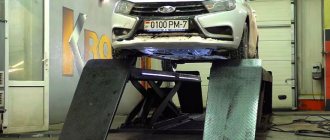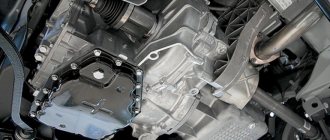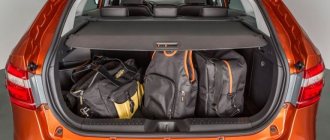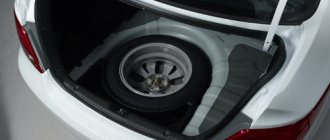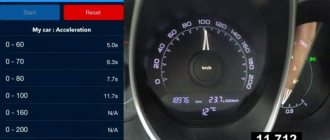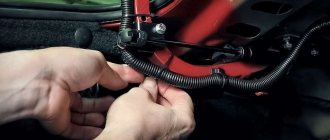One of the first Lada Vesta sedans went to Autoreview, where it is undergoing endurance tests. To date, the car has undergone 30,000 km of serious testing, which is equivalent to 100,000 km of daily mileage or 5 years of operation (in addition to the heavy load on all vehicle systems, there were corrosive loads). We'll tell you what breakdowns, sores and shortcomings await owners over such a period of time.
Transmission, engine and its systems
- No breakdowns of the VAZ-21129 engine (1.6 l, 106 hp) were recorded during the entire period of endurance testing. The power unit was serviced according to technical regulations.
- The fastenings of the decorative engine cover broke several times (see How to modify the engine cover).
- A slight chafing of the hose by the plastic cover of the engine was noticed (see What to do if hoses/pipes under the hood chafe).
- The heater radiator leaked.
- The muffler burned out.
- All muffler cushions (gingerbread) were torn 2 times.
- After 15,000 kilometers, 1st, 2nd and 3rd gears began to resist and were difficult to engage (the rod blocking block was stuck in its hole). Towards the end of the tests, the manual gearbox from Renault (JH3) began to howl with bearings, and it had to be repaired.
avtoexperts.ru
I have always had a positive attitude towards Lada Vesta. For me, this is a nice car, almost like a foreign car, which costs less than its competitors and is easy to maintain. Deciding to check what Vesta was like, I found a copy with a mileage of 40,000 km. I talked to the owner, drove it for a drive, and today I’ll tell you about what problems there are, as well as the advantages and disadvantages of the car.
Lada Vesta
The first positive point, as I wrote above, is the appearance. Whatever one may say, I like Vesta. She looks modern and stylish. Even the X-shaped stampings on the sidewalls look unusual and attract attention.
Note that the test car has a lowered suspension - minus 30 mm from stock. The owner installed Eibach springs for 10,000 rubles. Because he thinks that the standard Vesta is too high and looks ridiculous. I agree with him on this matter. In addition, at one time the car had 17-inch wheels, which created a more impressive look.
Lada Vesta on R17 wheels
Despite the lowered suspension, the ground clearance is enough to park close to curbs. If you drive up close to the curb, there is still a couple of centimeters left to the edge of the bumper.
We pulled up close to the curb
Let me remind you that the ground clearance of a standard car is 178 mm. This is more than any B-class competitors - Hyundai Solaris, Kia Rio, Volkswagen Polo and Skoda Rapid.
Speaking of competitors, it is worth saying that Vesta is at least 150-200,000 rubles cheaper than the above models. Perhaps this is the key factor that allows it to be number one in its segment.
Headlights
When you start studying the details, you understand why Vesta is cheaper than its competitors. The devil is in the details. For example, none of the configurations have LED optics. While the Korean and Czech-German representatives have them.
Lada Vesta, rear view
The front brakes are disc and the rear are drum. For versions with a 1.8 engine (122 hp) and a continuously variable transmission, rear disc brakes are available.
Vesta rear drum brakes
Let's return to our copy. The 2022 car is not in the cheapest configuration called Comfort. There is air conditioning, two airbags, a music system with Bluetooth, heated front seats, power windows in the front and rear parking sensors.
Interior of Lada Vesta
At the time of purchase, the car cost 621,000 rubles. Now such versions cost about 820,000 rubles. So prices have risen.
There is even an armrest, but only for the driver. The spirit of the Renault-Nissan alliance is recognizable in this moment. After all, a similar armrest was previously installed on many models, including the pre-reform Renault Kaptur.
Armrest Lada Vesta
By the way, the restyled 2022 models began to install a full-fledged armrest, as well as cup holders with increased capacity.
Armrest on modern versions of Vesta
There is enough space in the back for two passengers. I sit down behind myself and there are still a few centimeters left in front of my knees.
Rear seat
The trunk is not small and its volume is 480 liters, which is quite enough for a family person. True, when you open the trunk lid, you again notice a reduction in price. There is no trim on the lid or top of the trunk. Solaris, Rio, Polo and Rapid, in this regard, are doing better.
Luggage compartment
Please note that cars produced before September 2022 are slightly different. In particular, early models had a lock on the trunk lid, but now there is only a handle under the license plate.
Lada Vesta 2015
Also, the gas cap on new models does not have a recess.
Let's move on to the shortcomings and nuances that occurred during operation.
1. Door stops work in such a way that the door immediately opens wide. The owner installed a new type of limiter on one door, which has been installed on Vesta since 2019.
New door stop
2. Creaky original stabilizer bushings are a known weak point. At 10,000 km, they were replaced with new ones from Hyundai/Kia. The creak is gone. The price of each is 150 rubles.
Hyundai/Kia stabilizer bushings
3. The upper engine mount was replaced twice. The first time at 10,000 km, then at 20,000 km the owner installed a reinforced support from a VAZ 2110.
Upper engine mount
4. There were also problems with the lower support and it was replaced at 38,000 km. The part was taken from Renault Logan.
5. The exhaust system is also a weak point. For example, after 5000 km the original corrugation wore out. They replaced it, but at 20,000 km it came to an end again. They immediately installed a new set - a corrugation with a resonator.
Resonator with CBD corrugation
6. Under warranty, the anti-roll bar was replaced at 20,000 km, although the part could have lasted longer. The dealer supplied the part as a new one. The article number of the new spare part is 8450031594.
New stabilizer Lada 8450031594
7. The stabilizer struts were replaced at 35,000 km. The cost of the part is 500 rubles.
Front stabilizer
8. The brake discs were worn down at 30,000 km. The price of the set is about 2000 rubles, plus brake pads 500-900 rubles.
9. The front shock absorber struts were replaced at 5000 km. The manufacturer installed SAAZ companies, but they turned out to be short-lived. Then they chose Demfi - they are more reliable. Price - 3800 rubles per piece.
Saaz on the left, Demfi on the right
10. The repeaters in the side mirrors fogged up. The dealer corrected the defect under warranty by replacing the entire side mirrors.
Side mirrors
Having listed the weak points, you might think that Vesta consists entirely of shortcomings and breakdowns. In fact, this is not true. The engine, transmission and body are in perfect order. True, the five-speed transmission of the VAZ 21807 howls until the third gear, and from the fourth the extraneous noise goes away.
By the way, until 2016, the first Vestas were equipped with a Jatco JH3-510 transmission, which is better, but more expensive than the VAZ gearbox.
The 106 horsepower of the 21129 engine is enough for a quiet ride around the city and on the highway. When overtaking, you need to be careful and plan ahead. I would still like more power.
Engine 21129. Volume - 1.6, 106 forces and 14 Hm.
The 1.8-liter engine with an index of 21179 and 122 horsepower is also not particularly dynamic. Therefore, the optimal choice is the 1.6 106 hp engine, or the 113 hp Nissan H4M unit (HR16DE), which is paired with a CVT.
Engine 1.8 122 hp and 170 Hm.
The suspension is energy-intensive. True, our copy is equipped with soft Nokian Hakka Green 3 tires, measuring 185/65R15.
Road unevenness is periodically transmitted to the steering wheel, although the car has electric power steering and not hydraulic power steering. They say that the problem lies in the tie rods or the steering rack. Some owners modify the rack themselves and the knocking on the steering wheel goes away.
Instead of output
After getting to know Vesta from the inside, I can say that the car is far from ideal, but not problematic either. Although there could have been fewer problems. Thanks to AvtoVAZ.
All the shortcomings can be easily eliminated, especially since dealers most often agree to meet them. True, for 800-850,000 rubles, you don’t want to buy such a car, even if it’s new. But for 620,000 rubles, how much it cost in 2022, it’s quite possible. And even now on the secondary market such a copy costs about 500-550,000 rubles. For the money this is a great option.
Would you pay for a new Lada Vesta 800,000 for the average one or more than 1,000,000 rubles for the top-end configuration?
Sincerely, Airat Kadyrmaev.
Body
- The paint on the front bumper was peeling off from the gravel.
- The trunk lid is rubbing against the rear bumper.
- After 10 salt chambers, rust was detected only on the roof (see Checking the anti-corrosion treatment of the body).
Knocks in the suspension
In general, West levers last quite a long time. Extraneous noise may come from shock absorbers and stabilizer struts. The latter, by the way, sometimes did not live to reach 10 thousand km. Over time, the plant produced improved parts.
It is worth noting that car dealers agree to replace shock absorbers only in the case of clearly visible oil leaks. If the noise-producing elements are dry, the owner may be refused repairs.
Vesta's sores
- Wheel caps keep getting lost.
- The cover with the antenna fell off the roof of the car.
- The turn signals in the side mirrors fog up (see thread on the forum).
Rusting exhaust system corrugation
The short-lived exhaust tract has always been the weak point of the Lad, and Vesta is no exception. Corrugation rusts very quickly. For some time this does not appear in any way. However, after about 40 thousand km, the timbre begins to change, and in the end the “swallow” with the roar of a fighter has to go for repairs.
Previously, the production warranty was only 1 year or 35 thousand km. But now the domestic manufacturer is ready to replace the failed device within 3 years of operation (100 thousand km).
About spare parts
- Prices from official dealers are not the same, but may differ several times. For example, a set of front brake pads can cost from 1,500 to 3,800 rubles at different dealers.
- The most expensive spare part was the muffler - 11,000 rubles.
- Almost all spare parts for Vesta have to be purchased to order and wait on average 1 month.
Show/Hide text
| Costs for a Lada Vesta car | ||
| Mileage, km | What was spent on | Amount, rub. |
| 3500 | Wheel cap | 100 |
| 6375 | Brake pads | 2420 |
| 7930 | Exhaust system mounting support | 50 |
| 10020 | Exhaust system mounting support | 50 |
| 10020 | Brake pads | 1950 |
| 10100 | Wheel cap | 100 |
| 11790 | TO-1 (oil, oil filter) | 2800 |
| 12580 | Engine plastic cover retainer | 110 |
| 15850 | Brake pads | 1950 |
| 16260 | Wheel cap | 100 |
| 18320 | Exhaust pipe | 11300 |
| 20300 | Exhaust system mounting support | 50 |
| 23250 | Muffler suspension | 200 |
| 23750 | TO-2 (oil, oil, air, cabin filters, spark plugs) | 5500 |
| 25520 | Rear shock absorber | 3100 |
| 25600 | Antenna | 4500 |
| 26000 | Rear shock absorber | 3100 |
| 26800 | Rear suspension beam silent blocks | 1220 |
| 27600 | Brake pads | 1950 |
| 30300 | Wheel cap | 100 |
| 31200 | Wheel cap | 100 |
| 31500 | Heater radiator (complete with heater) | 19000 |
| 31800 | Release bearing | 4450 |
| 31800 | Secondary shaft bearing | 1450 |
| Topping up engine oil (for the entire period) | 320 | |
| Total for maintenance and repairs | 67920 | |
| other expenses | Tires (4 sets) | 44000 |
| Gasoline AI-95 (average consumption 12.3 l/100 km) | 145630 | |
| Total expenses | 257550 | |
pros
1. Options and prices.
Lada Vesta is more profitable than its competitors (see comparison with Hyundai Solaris) and to this day storms the top positions of top sales (see AEB sales statistics).
2. Controllability and stability
. There was good feedback in the steering wheel (see reviews from stuntmen), and the suspension had healthy elasticity and energy intensity.
3. Beautiful and spacious interior
. Comfortable driving position, more leg and shoulder room for the right passenger. Rear passengers have plenty of headroom. The interior design did not disappoint either (see interior dimensions).
4. Dimensions.
With body dimensions of 4,410 / 1,764 / 1,497 mm, Vesta belongs to class B+ and, being one of its largest representatives, gravitates towards the higher C-class. And the Vesta platform itself was made with an eye toward designing C-class cars.
5. Appearance
. For the first time in a long time, the words “beautiful” and “Lada” can be used one after another without the risk of falling under a hail of condescending laughter.
Results
According to experts from the auto magazine, Vesta behaved much better during endurance tests than expected. It is worth considering that the car came from the first production batch, and this is associated with many minor shortcomings and shortcomings. In her class, Vesta can be called a source of pride.
More details in the video:
Let us remind you that according to reviews from owners, squeaks and rattles may appear in the Vesta’s cabin (see how to eliminate it). And to extend the service life of the cabin filter, install a protective mesh on the air intake.
Keywords: Lada Vesta engine | roof of Lada Vesta | trunk of Lada Vesta | bumper Lada Vesta | side mirrors of Lada Vesta | cooling system for Lada Vesta | rear suspension of Lada Vesta | exhaust system for Lada Vesta | Lada Vesta brakes
0 0 0 0 0 0
Share on social networks:
Gluttonous 1.8 engine
The original 122-horsepower 1.8 unit, which had been reaching production cars for a long time, was disappointing in 3 ways: it turned out to be not very vigorous, and also greedy for fuel mixture and oil.
Car owners will have to come to terms with gasoline consumption in toffees exceeding 10 liters. But after upgrading the engine, we managed to get rid of two other problems.
To improve traction characteristics, engineers dug into the firmware. And to eliminate the oil burn, large-scale modifications to the hardware and assembly procedures were carried out.
Newsies have begun to complain less frequently, but individual episodes of increased oil consumption still occur.
Read - what kind of oil to pour into the Lada Vesta engine.
About the equipment and prices for the new Lada Vesta
In order to decide for yourself whether it is worth taking a domestic new car, you must, among other things, study the price with equipment, with other budget cars that are currently presented on the Russian car market.
LadaVesta occupies an advantageous position in terms of price. At the same time, it is necessary to take into account that our Vesta is inferior to its closest competitors in terms of the quality of materials used and even in the quality of assembly, and if we take this into account, then it is quite logical that it costs a little less. Again, this is the opinion of the experts.
Kalina does not pump the fuel pump
Kalina oxygen sensor signs of malfunction
Changing the oil in the Kalina box
